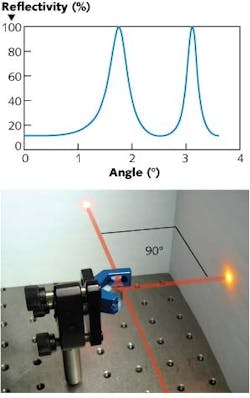LAB OPTICS: Beamsplitter has widely adjustable splitting ratio
In response to frequent requests for custom beamsplitters, the research and development staff at LightMachinery (Olean, ON, Canada) has developed an adjustable beamsplitter that the company calls a universal beamsplitter (UBS). The device has a reflectivity adjustable from 0% to about 90% and works at laser wavelengths across a broad spectral region (specific to the optical material used in the device).
“The inquiries we get are usually something like ‘Hello, I am looking for a 25% nonpolarizing beamsplitter cube at 532 nm,’” says John Hunter, president of LightMachinery. “But unless the customer is looking for a large quantity, the price is generally too high for a single beamsplitter for use in an R&D lab.”
So in early 2010 the company added the UBS to its list of R&D efforts. “Unfortunately, we had no idea how to create a universal beamsplitter,” says Hunter. The initial approach was to simply create a coated-plate beamsplitter with a reflectivity varying with angle of incidence. However, such a device would be awkward to use, as the beam would be reflected at odd angles; in addition, there were significant polarization effects at angles beyond a few degrees.
Fluid-jet-polished etalon
For a reflective surface, the engineers settled on a solid fused silica low-finesse etalon, which has a reflectivity curve that varies smoothly with angle (see figure). The beam hits the etalon at a low angle of incidence to minimize polarization effects. The transmitted beam has a very small parallel offset, typically 0.01 mm. Fluid-jet polishing enables the manufacturing of very flat, uniform-thickness 100 µm etalons. Next, to eliminate the varying angles of reflection, they added an extra high-reflectivity surface to create a modified retroreflecting layout so that the beam always emerges at 90º to the input beam.
The base of the UBS allows it to be mounted in a standard 25 mm adjustable mirror mount. Typical lab mounts have an adjustment range of about 4º, which encompasses the full reflectivity range of the UBS. The pivot point of the UBS lines up with that of the mirror mount such that the input and output beams stay aligned to the grid on the optical table.
The etalon is not the only way to create the UBS, says Hunter. The beamsplitter can also be made from a carefully designed thin-film coating; however, complex coatings can create stress, leading to the use of thicker material to avoid bending and leading to a significant walk-off of the transmitted beam.
The refractive index of the etalon material is a key parameter, notes Hunter. A higher index of refraction leads to a higher etalon finesse and a higher range of beamsplitting ratios. The wavelength range of the UBS is very broad, so it is difficult to create coatings that are wide enough. As such, designs using uncoated etalon materials are best. “Zinc selenide (ZnSe) is an interesting choice for the etalon material, since it has wide transmission range from the yellow to the far-IR and a very high index of refraction that creates a beamsplitter adjustable anywhere from 0%/100% to 50%/50% without any coatings,” says Hunter. “However, the transmission of ZnSe drops in the shorter-wavelength region. Fused silica is a reasonable choice from the UV to the near IR. But sapphire is probably our favorite material for the UBS. It has quite a high index, is very scratch-resistant, and has a very wide transmission range, from the UV through visible to about 5 µm in the IR.”
Is the UBS really universal? “No,” says Hunter. “Because the reflectivity also varies with wavelength as well as angle, the UBS only works with narrowband sources. This is another reason to keep the etalon thin so that the variation in reflectivity over a laser bandwidth remains insignificant. And the small UBS can only handle beams up to 3 mm in diameter.” But it does allow the optical engineer to use a single device as a 50/50 beamsplitter for a helium-neon laser one week and an 80/20 beamsplitter for a frequency-doubled YAG laser the next.
| FIGURE. The reflectivity of a 100-µm-thick solid fused-silica etalon varies widely with angle, making it suitable as the partially transmitting component of the UBS (top). A UBS mounted in a standard mirror mount splits a beam (path of beam is sketched in for clarity). (Courtesy of LightMachinery) |
